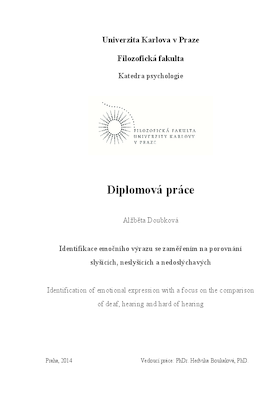Identifikace emočního výrazu se zaměřením na porovnávání slyšících, neslyšících a nedoslýchavých
Identification of emotional expression with a focus on the comparison of deaf, hearing and hearing-impaired
diplomová práce (OBHÁJENO)

Zobrazit/
Trvalý odkaz
http://hdl.handle.net/20.500.11956/71621Identifikátory
SIS: 136314
Katalog UK: 990018513280106986
Kolekce
- Kvalifikační práce [24991]
Autor
Vedoucí práce
Oponent práce
Čáp, David
Fakulta / součást
Filozofická fakulta
Obor
Psychologie
Katedra / ústav / klinika
Katedra psychologie
Datum obhajoby
8. 9. 2014
Nakladatel
Univerzita Karlova, Filozofická fakultaJazyk
Čeština
Známka
Výborně
Klíčová slova (česky)
Emoce, základní emoce, identifikace emocí, výraz emocí v obličeji, emoční výraz, sluchové postižení, neslyšící, nedoslýchavíKlíčová slova (anglicky)
Emotions, basic emotions, identification of emotions, facial expression of emotions, emotional expression, hearing impairment, deaf, hard of hearingTato diplomová práce je zaměřena na problematiku identifikace emočního výrazu v lidském obličeji. Teoretická část se zabývá úvodem do problematiky emocí, historií výzkumu identifikace emočního výrazu, popisem projevů jednotlivých základních emocí a jejich rozpoznáváním a charakteristikou skupiny sluchově postižených. V části empirické popisuji výzkum identifikace emocí v obličeji podle fotografií. Cílem této diplomové práce je zjistit odlišnost v přesnosti identifikace emočního výrazu mezi skupinami slyšících, neslyšících a nedoslýchavých a jejich vývoj napříč věkovými kategoriemi. Ve výzkumu jsem se zaměřila na sedm základních emocí (strach, hněv, smutek, překvapení, radost, znechucení a pohrdání) a jednu sociální emoci (stud). Závěry výzkumu mé předpoklady nepotvrdily. Žádný statisticky významný rozdíl se mezi třemi skupinami v celkové identifikaci emočního výrazu neprokázal. Jediná diference se ve prospěch slyšících projevila u rozpoznání znechucení. V celkovém porovnání věkových kategorií mezi sluchově postiženými (tj. neslyšící a nedoslýchaví dohromady) se rovněž neobjevil signifikantní rozdíl. Avšak při zaměření se na jednotlivé emoce byly zjištěny tyto významné diference: v kategorii 20 - 30 let smutek ve prospěch sluchově postižených, znechucení ve prospěch slyšících, ve skupině 30 - 40 let...
This thesis is focused on the identification of emotional expressions in the human face. The theoretical part includes an introduction to the issue of emotions, the history research on the identification of emotional expressions, the description of the various expressions of basic emotions and their recognition followed with the characteristics of the group of hearing-impaired. In the empirical part the research on the recognition identification of emotions in the face from the portraits is described. The aim of this thesis is to compare the accuracy of identification of emotional expressions among the groups of hearing, deaf and hard of hearing, and their development across all age categories. In my research I focus on the seven basic emotions (fear, anger, sadness, surprise, hapiness, disgust and contempt) and one social emotions (shame). The research did not confirm my assumptions. No statistically significant difference among the three groups in the overall identification of emotional expression was proved. The only difference was in the recognition of disgust which resulted in favor of the hearing. In the general comparison of ages between the hearing impaired (the deaf and the hard of hearing together) any significant differences were not discovered, either. Nevertheless, within each age...
